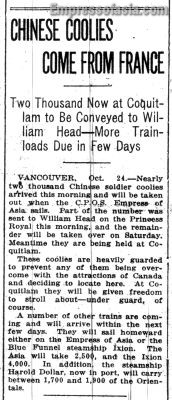Chinese Labour Corps
![]()
 The
heavy casualties that Great Britain sustained on the European Western Front
during World War One produced a labour shortage that became acute by 1916.
Great Britain responded to this labour crisis by recruiting labourers in China
and enrolling them into Battalions in a specifically created organization
referred to as the Chinese Labour Corps. Most of the labourers were recruited
in Shantung Province where Britain had an economic and military presence at
Weihaiwei. By early 1917, the first of the nearly 100,000 men who were to serve
with the British Army in France were sailing to Europe.
The
heavy casualties that Great Britain sustained on the European Western Front
during World War One produced a labour shortage that became acute by 1916.
Great Britain responded to this labour crisis by recruiting labourers in China
and enrolling them into Battalions in a specifically created organization
referred to as the Chinese Labour Corps. Most of the labourers were recruited
in Shantung Province where Britain had an economic and military presence at
Weihaiwei. By early 1917, the first of the nearly 100,000 men who were to serve
with the British Army in France were sailing to Europe.
While some members of the Chinese Labour Corps traveled to Europe by sailing westward across the Indian Ocean, the majority (over 76,000) traveled to France by crossing the Pacific Ocean. Pacific-bound ships were boarded at the Shantung ports of Weihaiwei and Tsingtao, and sailed across the Pacific disembarking at the Quarantine Station at William Head on Vancouver Island. From William Head, members of the Chinese Labour Corps sailed on smaller vessels across the Strait of Georgia to Vancouver. From Vancouver they were transported across Canada by rail to Halifax, where once again they boarded ships and sailed to Europe.
The EMPRESS OF ASIA, under the command of Captain A. W. Davison, played an important role in this movement of the Chinese Labour Corps from China to France carrying over 14,000 in 6 voyages from Shantung to British Columbia during 1917 and 1918.
The EMPRESS OF ASIA also played a role beyond the Pacific. The ship sailed from William Head on May 23, 1918 bound for Liverpool by way of the Panama Canal carrying 3,500 members of the Chinese Labour Corps.
In France, the Chinese Labour Corps provided vital services including unloading ships, building railways, digging trenches and construction.
The Chinese Labour Corps remained in Europe after the Armistice of November 11, 1918 assisting in Post War reconstruction, and did not begin repatriation until 1919. As in the journey to France, two distinct routes were utilized for the voyage home to China; While some sailed eastward across the Indian Ocean, a greater number travelled back to China via the Pacific Ocean. Approximately 75,000 members of the Chinese Labour Corps sailed westward to the Canadian East Coast, and then traveled across Canada by train to British Columbia.
To house the Chinese Labour Corps upon reaching British Columbia, a camp was built at Coquitlam and the facilities at William Head on Vancouver Island were readied. While some were ferried from Vancouver to William Head where they awaited a ship home, others boarded their homeward bound vessel directly at Vancouver.
Once again as in 1917 and 1918, the EMPRESS OF ASIA played a vital role in the movement of the Chinese Labour Corps. The EMPRESS OF ASIA, again commanded by Captain A. W. Davison, made three trips from Vancouver to Shantung during 1919 and 1920 and repatriated nearly 7,000 men.
In summary, the Chinese Labour Corps contributed approximately 100, 000 labourers to the war effort of Great Britain. This contribution, made necessary by the horrific losses on the Western Front, was essential for a British victory. Transporting the Chinese labour Corps to and from China was an ambitious undertaking in which the EMPRESS OF ASIA was significantly involved. In total, the EMPRESS OF ASIA transported nearly 24,000 members of the Chinese Labour Corps during World War One.
![]()
If you have arrived here and cannot see the Table of Contents to the left,
Please click HERE and visit our mainpage!